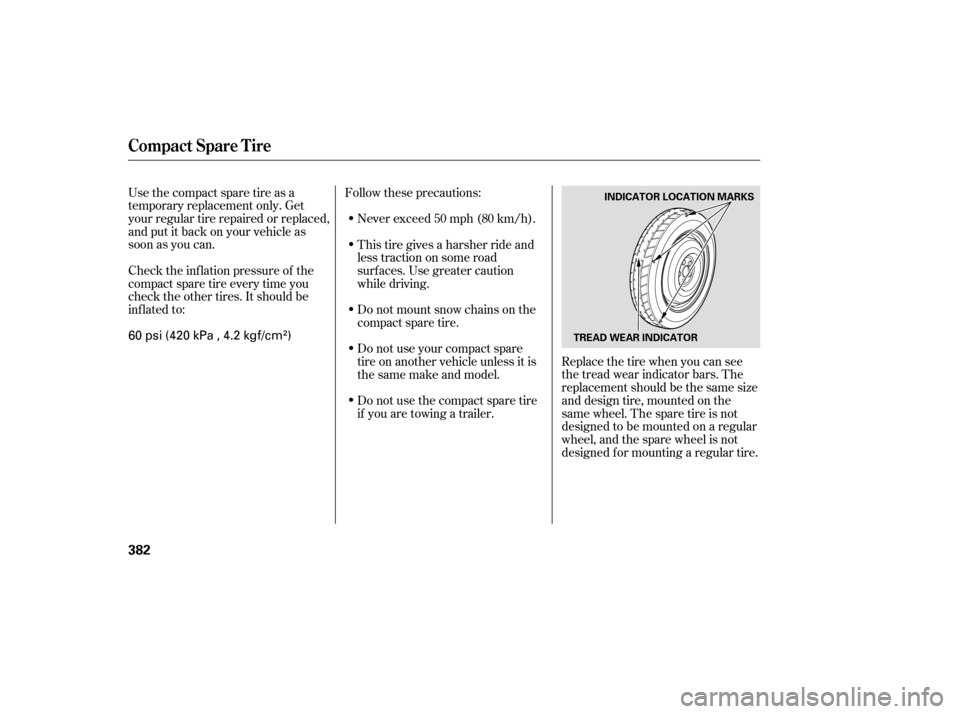Page 384 of 442

Fill the f uel tank.
Change the engine oil and f ilter.
Wash and dry the exterior
completely.
Cleantheinterior.Makesurethe
carpeting, floor mats, etc., are
completely dry.Block the rear wheels.
If the vehicle is to be stored f or a
longer period, it should be
supported on jackstands so the
tires are of f the ground.
Cover the vehicle with a
‘‘breathable’’ cover, one made
f rom a porous material such as
cotton. Non-porous materials, such
as plastic sheeting, trap moisture,
which can damage the paint.
If you need to park your vehicle f or
an extended period (more than 1
month), there are several things you
should do to prepare it f or storage.
Proper preparation helps prevent
deterioration and makes it easier to
get your vehicle back on the road. If
possible, store your vehicle indoors. Leave one window open slightly (if
the vehicle is being stored
indoors).
Disconnect the battery.
Support the f ront and rear wiper
blade arms with a f olded towel or
ragsotheydonottouchthe
windshield.
To minimize sticking, apply a
silicone spray lubricant to all door
and tailgate seals. Also, apply a
vehiclebodywaxtothepainted
surfaces that mate with the door
and tailgate seals.If possible, periodically run the
engine until it reaches f ull
operating temperature (the
cooling f ans cycle on and of f
twice). Pref erably, do this once a
month.
Leave the parking brake off. Put
the transmission in Park.
Vehicle Storage
380
�����—�����—�
���y�
�������������y���
�(�)� �������y���������y
Page 386 of 442

Use the compact spare tire as a
temporary replacement only. Get
your regular tire repaired or replaced,
and put it back on your vehicle as
soon as you can.
Check the inf lation pressure of the
compact spare tire every time you
check the other tires. It should be
inf lated to:Replace the tire when you can see
the tread wear indicator bars. The
replacement should be the same size
and design tire, mounted on the
same wheel. The spare tire is not
designed to be mounted on a regular
wheel, and the spare wheel is not
designed f or mounting a regular tire.
Follow these precautions:
Never exceed 50 mph (80 km/h).
This tire gives a harsher ride and
less traction on some road
surf aces. Use greater caution
while driving.
Do not mount snow chains on the
compact spare tire.
Do not use your compact spare
tire on another vehicle unless it is
thesamemakeandmodel.
Do not use the compact spare tire
if you are towing a trailer.
Compact Spare Tire
382
INDICATOR LOCATION MARKS
TREAD WEAR INDICATOR
60 psi (420 kPa , 4.2 kgf/cm)
�����—�����—�
���y�
�������������y���
�(�)� �������y���������y
Page 387 of 442

If you have a f lat tire while driving,
stop in a saf e place to change it.
Drive slowly along the shoulder until
you get to an exit or an area that is
far away from the traffic lanes.Park the vehicle on f irm, level, and
non-slippery ground. Put the
transmission in Park. Apply the
parking brake.
If you are towing a trailer, unhitch
it.
Open the tailgate. Raise the cargo
area f loor lid by lif ting it up with
the strap, then remove the lid.
The spare tire, jack, and tools are
under the cargo area f loor.
Turn on the hazard warning lights,
and turn the ignition switch to the
LOCK (0) position. Have all
passengers get out of the vehicle
while you change the tire.
Unscrew the wing bolt. Use the
hooked end of the wheel nut
wrench extension as a wrench if
the wing bolt is hard to loosen.
Then take the spare tire out of the
cargo area.
1.
2.
3.
4.
CONT INUED
Changing a Flat Tire
T aking Care of t he Unexpect ed
383
JACK
WING BOLT
LID
SPARE TIRE
The vehicle can easily roll off
the jack, seriously injuring
anyone underneath.
Follow the directions for
changing a tire exactly, and
never get under the vehicle
when it is supported only by the
jack.
�����—�����—�
���y�
�������������y���
�(�)� �������y���������y
Page 388 of 442
Loosen the f ive wheel nuts 1/2
turn with the wheel nut wrench.Placethejackunderthejacking
point nearest the tire you need to
change. Turn the end bracket
clockwise until the top of the jack
contacts the jacking point. Make
sure the jacking point tab is
restinginthejacknotch.
Remove the tools, wing bolt and
the jack. To remove the jack, turn
the jack’s end bracket
counterclockwise to loosen it.
6.
5. 7.
Changing a Flat Tire
384
JACKWING BOLT for normal tire
WHEEL NUTS
WHEEL NUT WRENCH JACKING POINT
TOOLS WHEEL NUTS
�����—�����—�
���y�
�������������y���
�(�)� �������y���������y
Page 389 of 442
CONT INUED
Use the extension and the wheel
nut wrench as shown to raise the
vehicle until the f lat tire is of f the
ground.
Remove the wheel nuts, then
remove the f lat tire. Handle the
wheel nuts caref ully; they may be
hot from driving. Place the flat tire
on the ground with the outside
surface facing up.Bef ore mounting the spare tire,
wipeanydirtoff themounting
surface of the wheel and hub with
a clean cloth. Wipe the hub
carefully;itmaybehotfrom
driving.Put on the spare tire. Put the
wheel nuts back on f inger-tight,
then tighten them in a crisscross
pattern with the wheel nut wrench
until the wheel is f irmly against
the hub. Do not try to tighten the
wheel nuts f ully.
Lower the vehicle to the ground,
and remove the jack.
8.
9. 10. 11.
12.
Changing a Flat Tire
T aking Care of t he Unexpect ed
385
BRAKE HUB
WHEEL NUT WRENCH EXTENSION
�����—�����—�
���y�
�������������y���
�(�)� �������y���������y
Page 390 of 442
Tighten the wheel nuts securely in
the same crisscross pattern. Have
the wheel nut torque checked at
the nearest automotive service
facility.
Tighten the wheel nuts to:
Store the jack in its holder. Turn
the jack’s end bracket to lock it in
place. Store the tools. Remove
the center cap from the
flat tire, and store it in the cargo
area.
Place the flat tire face up in the
cargo area.
Securetheflattirebyscrewing
the wing bolt back into its hole. Reinstall the cargo area f loor, and
close the tailgate.
Refer to
(see page ).
13.
14. 15.
16.
17.18.
19.
310
Changing a Flat Tire
Changing a T ire with
TPMS
386
For normal
tire
For spare
tire
80 lbf·ft (108 N·m , 11 kgf·m) Loose items can fly around the
interiorinacrashandcould
seriously injure the occupants.
Store the wheel, jack, and tools
securely before driving.
�����—�����—�
���y�
���������
���y���
�(�)� �������y�������
�y
Page 399 of 442

The brake system indicator (red)
normallycomesonwhenyouturn
the ignition switch to the ON (II)
position, and as a reminder to check
the parking brake. It will stay on if
you do not fully release the parking
brake.
If the brake system indicator (red)
comes on while driving, the brake
fluid level is probably low. Press
lightly on the brake pedal to see if it
feels normal. If it does, check the
brake fluid level the next time you
stop at a service station (see page
). If
the fluid level is low, take your
vehicle to a dealer, and have the
brake system inspected for leaks or
worn brake pads.
However, if the brake pedal does not
feel normal, you should take
immediate action. A problem in one
part of the system’s dual circuit
design will still give you braking at
two wheels. You will feel the brake
pedal go down much farther before
the vehicle begins to slow down, and
you will have to press harder on the
pedal.
You will also see a ‘‘BRAKE FLUID
LOW’’ message on the multi-
info rmation display (see page ).You
will also see a ‘‘CHECK BRAKE
SYSTEM’’ message on the multi-
info rmation display (see page ).Slow
down by shifting to a lower
gear, and pull to the side of the road
when it is safe. Because of the long
distance needed to stop, it is
hazardous to drive the vehicle. You
should have it towed, and repaired as
soon as possible (see on page ).
84
357 403
84
CONT INUED
On RDX with Technology Package model On RDX with Technology Package
model
Brake System Indicator
Brake System Indicator (Red)
Emergency
Towing
T aking Care of t he Unexpect ed
395
Canada
U. S.
�����—�����—�
���y�
�������������y���
�(�)� �������y���������y
Page 407 of 442
The operator will load
your vehicle on the back of a truck.
Any other method of towing will
damage the drive system. When you
contact the towing agency, inf orm
them a f lat-bed is required. If your vehicle needs to be towed,
call a prof essional towing service or
organization. Never tow your vehicle
with just a rope or chain. It is very
dangerous.
The only way you can saf ely tow
your vehicle is with f lat-bed
equipment.
Emergency Towing
T aking Care of t he Unexpect ed
403
Towing with only two tires on the
ground will damage parts of the
all-wheel-drive system. Your vehicle
should be transported on a f lat-bed
truck or trailer.
�����—�����—�
���y�
����
��������y���
�(�)� �������y���������y